Demand for ‘Scheduled Tribe’ status for Meitei
Relevance: GS I and II (Social Issues and Justice)
Why in news?
A long-standing demand of the Meitei tribe of Manipur is yet to be fulfilled by the Central Government for granting them the ST status.
- ST status for Meitei’s was considered and rejected in 1982 and 2001.
Meitei Tribe and reservation issue:
- According to the Meitei, they were recognized as a tribe before the creation of the state of Manipur in 1949. However, they lost their identity after the merger due to which they now feel marginalized and victimized without any Constitutional protections.
- As of now, according to the 2011 Census data, their population, which was 59% of the total population of Manipur in 1951, has now been reduced to 44%.
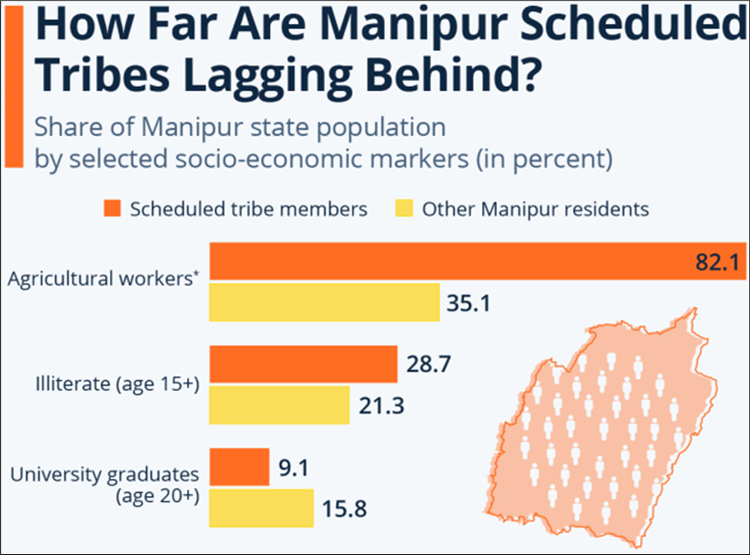
What will be the benefits of getting Meitei into the ST list?
- Inclusion in the 5th and 6th Schedule: Specific safeguards have been provided in Article 244 read with the provisions contained in the 5th and 6th Schedules to the Constitution.
- Reservation in Education: Reservation in educational institutions has been provided in Article 15(4) of the Constitution.
- Reservation for Employment: Reservation in posts and services has been provided in Articles 16(4), 16(4A) and 16(4B) of the Constitution.
- Reservation in Political Representation:
- Reservation of Seats for Scheduled Tribes in Panchayats is provided under Article 243D.
- Reservation of seats for Scheduled Tribes in the Lok Sabha is provided under Article 330.
|
The process of inclusion or exclusion from the Scheduled Tribes list:
|
Why are Meitei’s not included in the ST list?
- Social Status of Meitei Community:
- First, the Meitei community is considered as a dominant group in Manipur in terms of their numbers and need not be included in the ST list.
- Secondly, it noted that the Meitei people were Hindus and “assumed the status of Kshatriya Caste in the ladder of Hindu Castes”, adding that they had already been listed as Other Backward Classes.
- Meitei culture is already recognized: Meitei language is already included in the 8thSchedule of the Constitution, and some sections of the Meitei community are already classified under Other Backward Classes (OBC), which gives them access to certain educational and employment opportunities.
Conclusion: Making Tribal communities part of the democratic process and decision-making, upholding their Constitutional rights and preventing their exploitation is very primary step towards resolving the dilemma and making tribal communities a part of the developmental process.
PYQs
Mains:
Q1. What are the two major legal initiatives by the State since Independence addressing discrimination against Scheduled Tribes (STs)? (2017)
Q2. Why are the tribals in India referred to as ‘the Scheduled Tribes’? Indicate the major provisions enshrined in the Constitution of India for their upliftment. (2016)
Prelims:
Q1. The provisions in Fifth Schedule and Sixth Schedule in the Constitution of India are made in order to (2015)
(a) protect the interests of Scheduled Tribes
(b) determine the boundaries between States
(c) determine the powers, authority and responsibilities of Panchayats
(d) protect the interests of all the border States
Google manufacturing in India
GS Paper III
Context:
The Chromebooks, which are laptops that run on Google's Chrome operating system, are being built at the Flex facility near Chennai.
More details on the news:
- Chromebooks are among the most popular laptops in educational institutions worldwide but are yet to find mainstream traction in India, where most laptops run on Microsoft’s Windows operating system.
- India has put Google among the most high-profile names to begin manufacturing in India as companies worldwide look to diversify supply chains in response to geopolitical uncertainties.
- The move will help Google compete more effectively with Windows computers from companies such as Dell, Lenovo, and Asus.
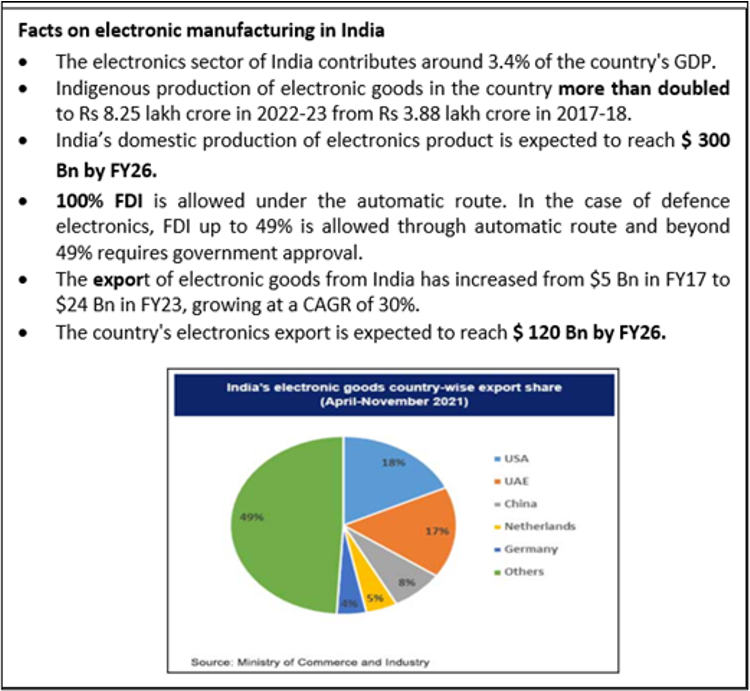
Importance of Google manufacturing for India
- Reducing dependency: It would help the company establish a localized supply chain, reducing dependency on external suppliers and potentially lowering production costs.
- Establishing as a trusted partner: India seeks to establish itself as a “trusted partner” in global supply chains at a time when companies, especially from the US, are looking to diversify away from China, which has been the hub of such manufacturing for decades.
- Diversifying the market: While India has a big domestic demand for laptops and computers, almost all of it is currently being fulfilled by imports from China, something New Delhi wants to change as soon as possible.
India’s policy to discourage Chinese electronics imports:
- Curb on Chinese electronic goods: India wants to reduce electronic imports from China as the country has seen an increase in imports of electronic goods and laptops/computers in the last few years.
- In August 2023, the government attempted to impose a licensing requirement on the import of laptops and computers, but it was forced to delay the implementation of the directive after a strong pushback from the industry.
- The Centre has now introduced the so-called “import management system”, under which companies will be required to register and disclose data related to their imports, including countries from which they import electronic hardware such as laptops and personal computers, and domestic sales value.
- The government also plans to impose a condition on companies to reorient their supplies from “trusted sources”, a move that is squarely aimed at reducing import dependence on China.
Challenges for electronic manufacturing in India:
- Shortage of Skilled labor: In the areas of electronics and semiconductor manufacturing.
- Competition from other countries: There is stiff competition for India from China, Taiwan, Vietnam, and South Korea, which have well-established electronics manufacturing sectors, offering lower production costs.
- Issue of supply chain: Inadequate supply chain infrastructure in India, including ports, customs processes, and transportation can create inefficiency.
- Taxation issue: The complex and frequently changing tax structure in India can make it less competitive with other countries in the region.
- IPR concerns: Issues related to intellectual property rights enforcement and protection can deter investment and innovation in the sector.
- Inadequate infrastructure: Such as power supply, transportation, and logistics, this is often unreliable and inadequate.
Steps taken by India
- National Policy on Electronics: To boost its electronics systems and design manufacturing industry.
- Ease of Doing Business: To improve the ease of doing business in India this includes streamlining regulatory processes.
- Sector-specific policies: The government has introduced sector-specific policies to support areas like mobile manufacturing, LED lighting, etc.
- Schemes: The schemes such as Production-Linked Incentive (PLI) Scheme, Scheme for Promotion of Manufacturing of Electronic Components and Semiconductors (SPECS), Modified Electronics Manufacturing Clusters Scheme (EMC 2.0), Modified Special Incentive Package Scheme (M-SIPS), etc. are most significant initiatives to promote electronic manufacturing in India.
- R&D support: The Ministry of Electronics and Information Technology (MeitY) has launched the Electronics Development Fund (EDF) to support startups and innovation in the electronics sector.
Way forward:
- State-of-the-art facilities: Develop and upgrade industrial parks with state-of-the-art facilities for electronic manufacturers.
- Favorable investment climate: Simplify regulations and reducing bureaucratic hurdles for setting up manufacturing units.
- Export-focused policies: Help Indian electronics manufacturers to compete in global markets.
- Support for electronics startups: Provide funding and support for electronics startups and entrepreneurs to encourage innovation in the sector.
- Promotion of IoT and Industry 4.0: Encourage the adoption of Internet of Things (IoT) and Industry 4.0 technologies in electronic manufacturing processes.
- Better tax incentives: Offer favorable tax incentives and subsidies for electronics manufacturers.
Conclusion:
Boosting electronic manufacturing in India is crucial for reducing import dependency and promoting domestic production. While progress has been made, addressing challenges such as infrastructure, skilled labor, and competition with other countries remains a continued effort that will require concerted efforts from both the government and industry stakeholders.
PYQ’s:
Q1. Recently, India’s first ‘National Investment and Manufacturing Zone’ was proposed to be set up in
(UPSC 2016)
(a) Andhra Pradesh
(b) Gujarat
(c) Maharashtra
(d) Uttar Pradesh
Q2. What is/are the recent policy initiative(s) of Government of India to promote the growth of manufacturing sector?
- Setting up of National Investment and Manufacturing Zones
- Providing the benefit of 'single window clearance'
- Establishing the Technology Acquisition and Development Fund
Select the correct answer using the codes given below:
(a) 1 only
(b) 2 and 3 only
(c) 1 and 3 only
(d) 1, 2 and 3
Q3. Can the strategy of regional-resource based manufacturing help in promoting employment in India? (UPSC 2019)
Q4. Account for the failure of manufacturing sector in achieving the goal of labour-intensive exports. Suggest measures for more labour-intensive rather than capital-intensive exports. (UPSC 2017)
Concerns with iron-fortified rice
GS Paper – III
Context:
Recently, the Supreme Court directed the Centre to respond to concerns regarding the government’s iron-fortified rice program and its indiscriminate distribution to even those suffering from thalassemia and sickle cell disease.
Background:
- The Food Safety and Standards Authority of India’s statutory regulations have warned patients with thalassemia and sickle cell anaemia against consuming iron-fortified food or using it only under strict medical supervision.
- Consuming iron could lead to adverse outcomes like organ failure for people with such conditions. This means that giving iron-fortified rice indiscriminately, without any screening for such patients, is a non-compliance of the government with their own warnings.
- The government approved the fortification of the key staple rice in August 2022 in all government food schemes and entitlements under the National Food Security Act 2013.
|
Food fortification:
|
Thalassemia: Thalassemia is an inherited blood condition. If one has it, his/her body has fewer red blood cells and less haemoglobin than it should. Haemoglobin is important because it lets the red blood cells carry oxygen to all parts of the body. Because of this, people with this condition may have anaemia, which makes them feel tired.
- Causes: Haemoglobin is made of two proteins: Alpha globin and beta globin
- Thalassemia occurs when there is a defect in a gene that helps control the production of one of these proteins.
- Types: There are two main types of thalassemia:
- Alpha Thalassemia: It occurs when a gene or genes related to the alpha globin protein are missing or changed (mutated). It occurs most often in people from Southeast Asia, the Middle East, China, and those of African descent.
- Beta Thalassemia: It occurs when similar gene defects affect the production of the beta globin protein. It occurs most often in people of Mediterranean origin.
- Symptoms: Slow growth in children, wide or brittle bones, enlarged spleen, fatigue, weakness.
Sickle Cell Anaemia:
- Sickle cell anaemia is a form of inherited blood disorder. It affects the red blood cells, turning them from round flexible discs into stiff and sticky sickled cells.
- Sickled cells keep red blood cells from doing their job, which is carrying oxygen throughout your body.
- Sickled cells also don’t live as long as normal red blood cells. As a result, one doesn’t have enough healthy red blood cells and develops anaemia, the condition that gives sickle cell anaemia its name.
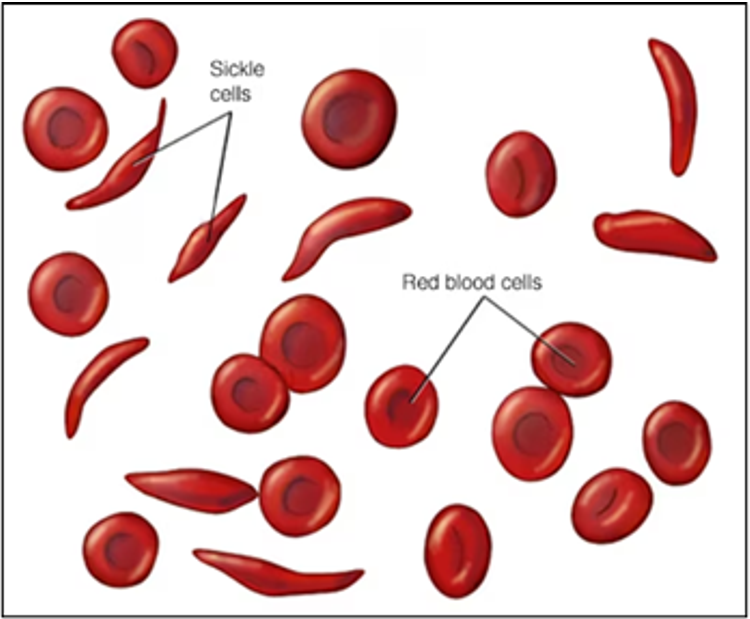
- Causes: Sickle cell anaemia is caused by a change in the gene that tells the body to make the iron-rich compound in red blood cells called haemoglobin. The haemoglobin associated with sickle cell anaemia causes red blood cells to become rigid, sticky, and misshapen.
Status of genetic diseases in India:
- As per an estimate from the Union Ministry of Health and Family Welfare, India could be home to over eight crore persons suffering from rare diseases - an umbrella term used to denote a spectrum of over 5000 diseases usually of genetic origin.
- Around 80% of rare diseases have an identified genetic origin and hence disproportionately impact children.
- Over 50% of new cases are in children and are responsible for 35% of deaths before the age of 1 year, 10% between the ages of 1 and 5 years, and 12% between 5 and 15 years.
- The list includes Haemophilia, Thalassemia, Sickle-cell Anaemia and Primary Immuno-Deficiency in children, auto-immune diseases, lysosomal storage disorders (such as Pompe disease, Hirschsprung disease, Gaucher’s disease, Cystic Fibrosis, Hemangiomas) and certain forms of muscular dystrophies.
- Alarmed over the situation, MOHFW is working on a national policy for rare diseases. Technical and inter-ministerial committees are already in place to evaluate the issue.
Conclusion:
Genetic diseases like Thalassemia and Sickle cell anaemia are often chronic, progressive, degenerative, and life-threatening. Hence, there is a need for gentler, safer, long-term, and sustainable solutions, that involve the community and stimulate diet diversification, especially with simultaneously ongoing initiatives to increase iron intake. It is imperative to resist the fascination with technology and universality and go for local solutions for global problems.
Decline in wildlife species
Relevance: GS III (Environment)
Context
Two recent studies – State of India’s Birds Report 2023 and the study on Amphibians highlighted the need to keep a watch on wildlife.
|
Background/Successful Case study:
|
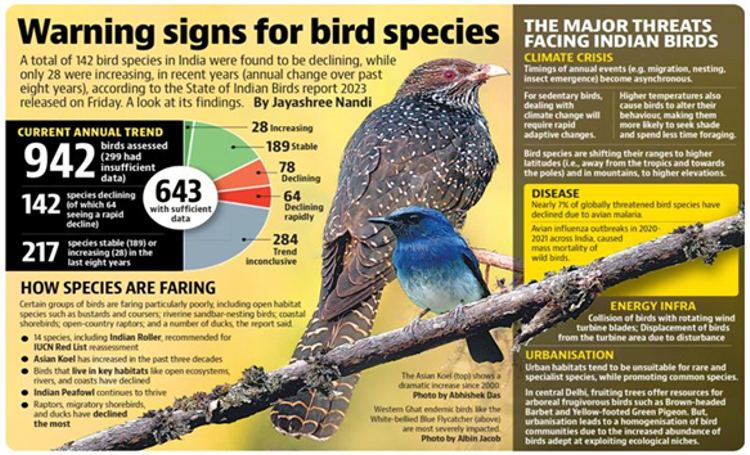
Highlights of the reports:
- The State of India’s Birds Report 2023 identified a rapid decline of many bird species and an increase in some. The distribution of species is severely affected throughout the length and breadth of the country.
- The study on Amphibians published in the journal Nature highlighted that many species have been pushed into the threatened category, which will eventually lead towards their extinction.
- Climate change is the major factor in the decline of the species followed by conservation regulations.
- The change in their distribution can have serious repercussions as birds and amphibians are important indicators of the health of an ecosystem.
- Species distribution modelling under current and future climate change scenarios and revision of conservation regulations can help in the conservation of species.
Species distribution modelling:
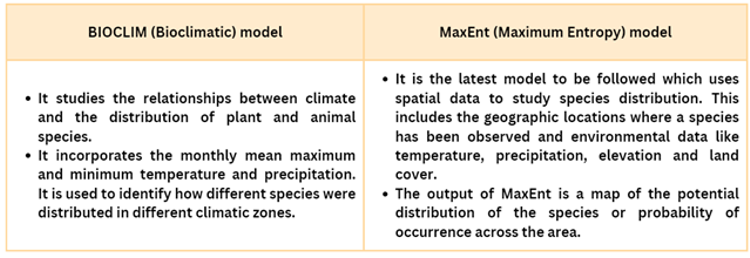
Issue of Data availability:
- One of the major constraints to using species distribution modelling is the data limitation both on species occurrence and environmental parameters like forest cover.
- For numerous endangered species of birds, reptiles, butterflies and primates, the species occurrence data is not Similarly, environmental data like tree cover is also not available.
- Impacts: In the absence of such data, it is hard for researchers to examine the ecosystem changes from grassland to shrubland or the increase of vegetation in alpine meadows or forests becoming drier which has led to the range expansion of species.
Conservation regulations - Wildlife Protection (Amendment) Act, 2022
- Many ecologists are incensed that an inordinate number of species have been included in the new schedules of the act, without an objective or replicable process. For ex about 600 species of vertebrates and hundreds of invertebrates are included in Schedule 1 (highest protection), while Schedule 2 contains about 2,000 species (with 1,134 species of birds alone).
- The act aligns itself with CITES and includes the CITES appendices as well. The act does not provide a clear connection between endangerment and conservation.
- Listing vast species of mammals, birds and innumerable other taxa means that it is unclear where resources should be allocated. The same level of protection is offered to tigers and jackals, great Indian bustards and common barn owls, king cobra and rat snakes.
Way forward
- All three issues – species distribution modelling, data availability and conservation regulations need to be attended to.
- Management actions for species and habitats need to be tailored to ecology and species biology.
- Proper research and regular monitoring, which is currently hampered by the scheduling of species needs to be resolved.
- Fieldwork is essential to train species distribution models and validate the results. It requires the collaboration of government and private researchers along with data democratisation. This will collectively benefit India’s biodiversity conservation goals.
- Finally, both citizens and ecologists have a right to observe nature and collect data if they so desire, as long as it does not cause undue harm to populations, and follows the basic principles of the ethical treatment of animals.
PYQ’s
Q1. In India, if a species of tortoise is declared protected under Schedule I of the Wildlife (Protection) Act, 1972, what does it imply? (UPSC 2017)
(a) It enjoys the same level of protection as the tiger.
(b) It no longer exists in the wild, a few individuals are under captive protection; and now it is impossible to prevent its extinction.
(c) It is endemic to a particular region of India.
(d) Both B and C stated above are correct in this context.
Q2. According to the Wildlife (Protection) Act, 1972, which of the following animals cannot be hunted by any person except under some provisions provided by law? (UPSC 2017)
- Gharial
- Indian wild ass
- Wild buffalo
Select the correct answer using the code given below:
(a) 1 only
(b) 2 and 3 only
(c) 1 and 3 only
(d) 1, 2 and 3
Q3. How does biodiversity vary in India? How is the Biological Diversity Act,2002 helpful in conservation of flora and fauna? (250 Words, 15 Marks) (UPSC 2018)
Lok Sabha Ethics Committee
Context:
- Recently, the Lok Sabha Speaker has referred a case of accepting money by an MP from a businessman to ask questions in Parliament to the House Ethics Committee.
About Ethics Committee:
- This committee was constituted in Rajya Sabha in 1997 and in Lok Sabha in 2000.
- The Speaker appoints members of the committee for one year.
- It enforces the code of conduct of members of Parliament.
- It examines the cases of misconduct and recommends appropriate action.
- Thus, it is engaged in maintaining discipline and decorum in Parliament.
69th National Film Award
Context:
The President of India presented the 69th National Film Awards in various categories in New Delhi.
Highlights of the 69th National Film Award:
- Among the winners are actors Allu Arjun, who won the Best Actor award for the film Pushpa: The Rise, and Alia Bhatt and Kriti Sanon, who shared the award for Best Actress for their films, Gangubai Kathiawadi and Mimi respectively.
- Rocketry: The Nambi Effect won the award for Best Feature Film.
- The Kashmir Files won the Nargis Dutt Award for Best Film on National Integration at the 69th National Film Awards.
- Shoojit Sircar’s historical drama Sardar Udham also won several awards.
- Waheeda Rehman received the Dadasaheb Phalke Award.
National Film Awards:
- Established in 1954, the National Film Awards is one of the most prestigious and much-looked-forward-to events in the country.
- The Hon'ble President of India presents the awards culminating in showcasing award-winning films for the public.
- The Awards are categorized into three sections - Feature Films, Non-Feature Films, and Best Writing on Cinema.
- In addition, a lifetime achievement award, named after the father of Indian cinema Dadasaheb Phalke, is awarded to a film personality for outstanding contribution to the growth and development of Indian Cinema.


